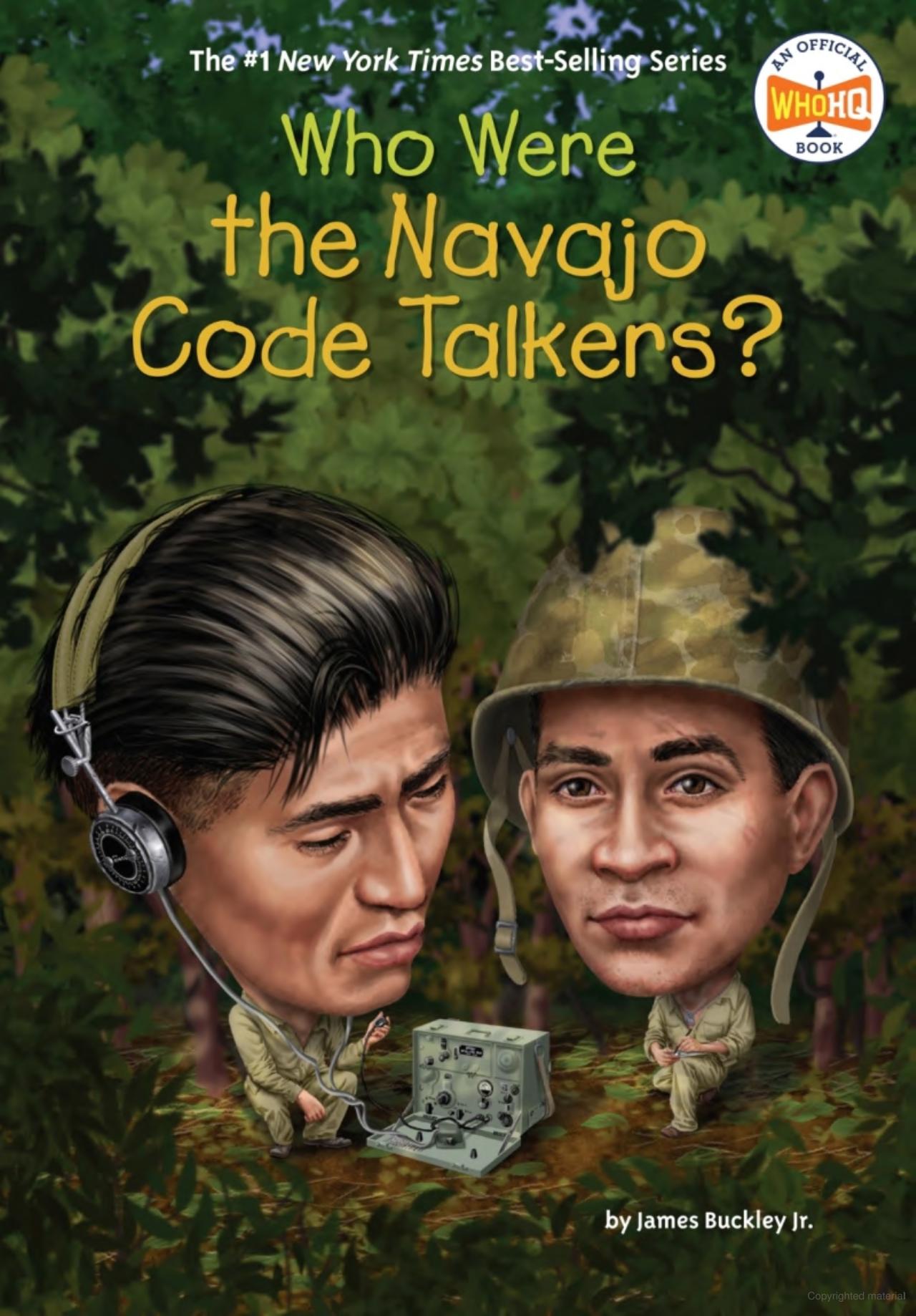Who Were the Navajo Code Talkers?
As loud explosions echoed off the rocky island, Samuel Holiday leaped off the landing craft as the huge metal machine slammed into the beach. Samuel was a United States Marine. And the beach was on Iwo Jima, an island in the Pacific Ocean that was held by the Japanese as they battled the United States in World War II. Bullets pinged all around Samuel, while bombs sent huge plumes of black sand into the air. Samuel did his best to walk toward a safe position, but the sand was loose and shifted constantly. Every step was a huge struggle. As he plunged ahead, he saw Marines who had been killed almost as soon as they stepped ashore, lying where they fell.
Samuel clutched his rifle and shouldered the big radio on his back. He had to make it through
safely. He had an important job to do. Samuel was one of the Navajo code talkers. These specially trained Marines made sure that thousands of US soldiers, sailors, ships, and planes could get their messages through safely without the Japanese being able to read them. Using their Diné language, the code talkers had become a vital part of the US Marines’ mission. Without a secure way to communicate, that mission on Iwo Jima might end in disaster.
Samuel dug out a place where he was safe from bullets for the moment. He and his Akee, set up their radio gear. partner, Dan
“Bil-dah-has-tanh-ya,” Samuel said over the radio. “Al-tah-je-jay yoehi ashdla!” On the other end of the call, another Navajo code talker was listening. He told his own partner what Samuel had said: “Pinned down! Attack Sector Five!” The order was passed to Marine artillery. Moments later, bombs landed in front of Samuel, destroying the secret position of the enemy soldiers. The Japanese radio operators who were also listening had no idea what Samuel had said, and their location had been exposed.
Samuel and the other code talkers were in constant danger on Iwo Jima. “The [gun]fire was so intense, men were being killed all around me, and we were pinned down and couldn’t move,” remembered code talker Teddy Draper. “I kept wondering if I was going to live through the day or be killed in my foxhole.” (A foxhole is a dugout pit big enough to hold one or two soldiers.)
Teddy and Samuel did live, and thanks to more than four hundred Navajo code talkers, so did thousands of their fellow Marines. For almost four years, from 1942 to 1945, the code talkers fought in battle after battle. Their unbreakable code helped make sure the enemy could not intercept military communications and that Marines were protected. The code, created using the Navajo language, was never broken. Then, for almost twenty-five years after the war ended, their story was kept as secret as their code-but now it can be told.
CHAPTER 1 The Navajo
For more than one thousand years, Native Americans of the Navajo Nation have been living in the American Southwest. The Navajo, who call themselves Diné (say: DEE-nay), built homes and villages, created systems of traditions and beliefs, and spoke a unique language.
Europeans arrived on the East Coast of North America in the 1500s and started moving westward toward the lands of the Navajo and many other Native American nations. Soldiers from Spain came to the land of the Navajo in the 1540s. They forced the Navajo off the best farming land and tried to convert the Native Americans to the Spaniards’ Catholic religion.
For hundreds of years, the two groups fought throughout the American Southwest, with many deaths on both sides.
In the 1830s, white American settlers began to arrive. A US Army fort was built near Window Rock in 1851, deep in the heart of Navajo territory in what is now Arizona. Soldiers again tried to force the Navajo people off their own land and onto reservations, which were areas
set aside for resettling Native Americans. The reservations were often far from the Native Americans’ homes and did not have land that was good for farming or had enough water sources. Few reservations provided much area for shelter. The Navajo tried to resist, but the US Army was too powerful. The army killed horses and sheep, burned cornfields, and killed many Navajo.
Several times, the army forced the Navajo people on a “Long Walk” to a desolate reservation in New Mexico called Bosque Redondo. Hundreds of Navajo died during several of these forced walks, some of which were as long as 450 miles. The Navajo never gave up, however. After resisting the US Army for decades, they signed a treaty in 1868 that gave the Navajo back their homeland. Today, that land is the Navajo Nation. It surrounds the Four Corners region of the United States, where Utah, Colorado, Arizona, and New Mexico meet. Through it all, the Navajo people kept their faith, their traditions, and their language.
Comprehension Questions
1. What was Samuel a part of?
A. Chippewa Code Talkers
B. Navajo code talkers
C. Cherokee Code Talkers
A. 1930's
B. 1860's
C. 1830's
Your Thoughts
Vocabulary
4. List any vocabulary words below.

